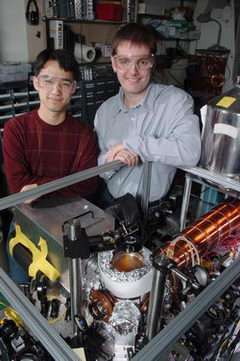Laser-trapping of rare element gets unexpected assist

Argonne researchers have successfully laser-cooled and trapped atoms of radium — the first time this rare element has been captured in a magneto-optical trap — with an assist from an unexpected source.
The group of physicists was attempting to trap the rare, radioactive element for studies of time-reversal violation, explained Argonne Compton Postdoctoral Fellow Jeffrey Guest of Argonne's Physics Division. Finding examples of this effect has implications for physics beyond the Standard Model and for explaining why the Big Bang yielded an imbalance between matter and antimatter in the universe.
Starting with less than a millionth of a gram of radium, the scientists vaporized, laser-cooled and captured the radium atoms in a magneto-optical trap. "This is the first time this rare element has been laser-cooled and trapped," Guest said. "It is the heaviest atom and only the second element with no stable isotopes — after francium — laser-trapped so far. It was particularly challenging to trap radium because quantities are scarce, and the atomic structure is not well studied and understood."
Radium atoms were slowed to a crawl and captured with magnetic fields and laser beams tuned near the atoms' resonant frequency. Future experiments will probe the cold radium atoms with lasers as they spin in place in a large electric field. The atoms will precess — wobble about their axes like tops winding down — as they spin. The frequency of this precession may reveal a slight offset between the negative and positive charge within the atom along its spin axis, a signature of time-reversal violation.
"Because their nuclei are egg-shaped, radium nuclei should be very sensitive to the time-reversal effects we want to investigate," Guest said. "However, radium is difficult to work with. Atoms tend to drift out of the trap, and because of radium's chemistry, it would stick to the walls of the vacuum chamber."
However, researchers were surprised to find the radium atoms were staying put much longer than expected. "We were surprised to discover that room temperature blackbody radiation actually played a pivotal and supportive role," Guest said.
Blackbody radiation is essentially heat; in this case, infrared radiation coming from the room-temperature walls of the apparatus. It's often a nuisance for experiments in physics, causing heating, contributing to background noise and scrambling quantum phases. However, when the radium atoms fell into metastable atomic states— in which the atoms could no longer “see” the trapping lasers — during the laser-cooling, the blackbody radiation added enough energy to the atoms to "recycle" them back to a configuration in which they could “see” the lasers again. This allowed the lasers to do their work and hold the atoms in place.
"This mechanism may be helpful in trapping other atoms with complex structure," Guest said.
The current effort in the laboratory is focused on adding a dedicated measurement apparatus to the experiment to begin the search for evidence of time-reversal asymmetry. Experiments with radium nuclei will begin in earnest.
A report on this achievement was recently published — and marked as a “suggestion” by the editors — in Physical Review Letters (PRL 98, 093001 (2007)).
Source: Argonne National Laboratory




















